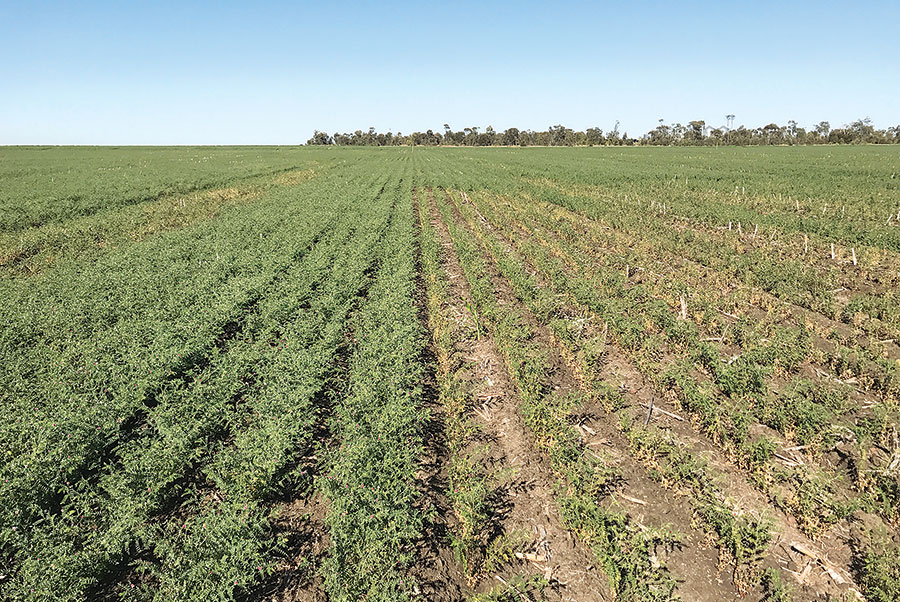Key points
- Long-running research continues to illustrate that nutrient deep banding is important in addressing the northern region’s declining soil fertility
- Via GRDC-supported projects, the University of Queensland’s Professor Mike Bell has led many fertility projects over the past decade
- Working with the Queensland Department of Agriculture and Fisheries’ Dr Dave Lester and Doug Sands, private agronomists and growers have seen deep-placement trials improve soil health and crop yields
- The deep banding of phosphorus and potassium tackles two issues – these nutrients’ immobility in clay soils and the region’s reliance on stored soil moisture
- For Capella grower David Storey, the costs associated with applying high rates of deep-banded phosphorus and/or potassium were almost recouped in one crop.
“In chickpeas, it nearly paid off in the first year,” David says. “Chickpea yield increases essentially paid for the cost of it in one go.”
With his wife Megan, brother Alan and sister-in-law Geri, David farms more than 3000 hectares just north of Emerald in Central Queensland.
About five years ago, on-farm Queensland Department of Agriculture and Fisheries (DAF) trials showed the value of these deep-placed nutrients, prompting the Storeys to start a deep-banding program. High rates of phosphorus and/or potassium were placed at a depth of 20 centimetres in 50cm rows.
The deep banding of phosphorus and potassium tackles two issues – these nutrients’ immobility in clay soils and the region’s reliance on stored soil moisture. When crops dig deep for moisture, they also need to find nutrients.
Long-running GRDC-supported research continues to illustrate that nutrient deep banding is important in addressing the northern region’s declining soil fertility.

Chickpeas on the left-hand-side of the paddock are visibly thriving compared with those on the right. The left-hand-side had 40 kilograms of phosphorus per hectare applied as MAP in deep-banded trials. Those on the right were part of a control treatment that had background fertiliser applied but no phosphorus. Photo: Doug Sands
The Storeys are among a number of growers who are deep banding.
For David, yields have increased across all five years, but this can be hard to quantify. “We always leave zero strips to check them against our deep-banded country. But sometimes when you’re in a rush at harvest, you harvest them with everything else. But where it is placed, the crop is always further ahead than other crops.”
The Storeys use a 12-metre planter for the job. “We bought it so we don’t wreck our planter, because deep placement can be hard on gear. The other issue is that you can bring rocks up too, which then cause hassles in other operations. It would be great if we could use a huge disc that could open the soil and then place it back down.”
David says it is about time to start another round of deep banding, with some of the earlier paddocks done five years ago.
To help decide on that, the Storeys undertake some strip tests. “We like to put some strips in and see how they go and then decide. That will happen around Christmas now that we have planted.”
He says the process of deep banding can potentially cost a crop in terms of associated moisture loss, but the benefits outweigh this risk.
Benefits and barriers
Central Queensland agronomist Josh Bell, from JB Ag Services, says the deep-placement research is some of the best done in a decade.
“It has shown good, clear responses. We’ve seen increases of 20 to 50 per cent in yield, particularly in chickpeas where nitrogen is not limited.”
Josh says about half his clients have tried phosphorus and potassium deep placement, and more intend to but lack either the right equipment or the opportunity.
“Application timing is a bit tricky. You need to have some surface moisture to facilitate the job without too much soil disturbance. But we try to avoid applying phosphorus and potassium leading up to planting when we have a good moisture profile, in case we ruin the prospects of getting a crop planted. Instead, applying when there’s some surface moisture early in a fallow before the profile fills with moisture is ideal.”
A good time to try is October or November, he says, “or when you’ve missed a winter cropping opportunity”.
He says it is important to undertake some soil testing prior to any application to determine likely responses. “DAF has developed a very good guideline around this. Some soils are marginal and may not respond and others certainly don’t need deep placement.”
Moree-based grower Michael Ledingham started the deep-banding process to address low phosphorus levels about a decade ago. Machinery issues and the drought meant the program has stalled, but he is starting again.
He agrees that choosing when to apply can be a challenge. “It’s often dry after harvest, so it’s tighter ground conditions, so more horsepower and fuel are needed. Later on, it is wetter, but we risk moisture loss and getting the field ready for sowing.”
GRDC Northern Panel member and retired agronomist Graham Spackman has extensive experience with deep-placed phosphorus and potassium. With fertiliser prices high, he says, there is an opportunity to undertake some soil testing.
“Perhaps do a few test strips while the prices are high and work out what is appropriate for your soil. This is the opportunity to see if deep banding works and get all the ducks aligned so that when fertiliser prices come down, you can go for it. Those that have tried it on deficient soils have been very successful in most cases.”
More information: Michael Ledingham,

























































